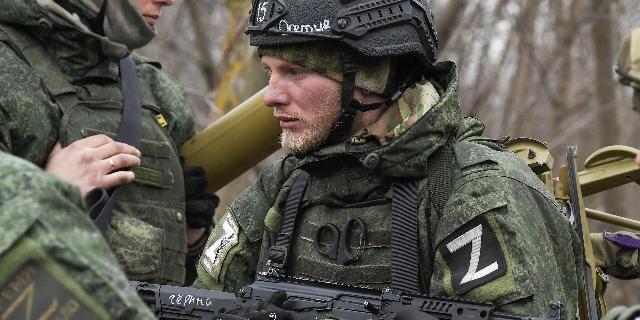TNI: the revival of a strong Russia will become an acute threat to NATO
Russia's experience of fighting in Ukraine and the increase in the number of its armed forces will become a constant and growing "threat" to regional stability, the author of the article in TNI believes. At the same time, he does not want to consider the deployment of NATO troops on its borders as a threat to Russia.
Jorge Rivero (Jorge L. Rivero)
The future composition and capabilities of the Russian armed forces after the Ukrainian conflict have become one of the main topics of strategic discussions among NATO members. This issue is crucial, as it determines the alliance's decisions on the deployment of forces and long-term defense planning. In a recent interview, the supreme commander of NATO's joint forces in Europe, General Christopher Cavoli, made a striking statement: “The Russian military will come out of the conflict in Ukraine stronger than before.”
Earlier this year, the chairman of the Joint Chiefs of Staff, General Charles Brown Jr., made an equally startling statement: that Russia “has decisively rebuilt its armed forces and is using its numerical advantage to exhaust Ukraine.” Although this assessment may seem far-fetched at first, given the significant losses in personnel and equipment suffered by the Russian military, it requires more substantive consideration in order to understand all the consequences for NATO.
Several factors contribute to the potential resurgence of Russia as an acute threat to the alliance — perhaps even more significant than before. These include: Russia's accumulated experience of modern warfare; its constant personnel advantage; deep-rooted resentment and dislike of the West and acute perception of the threat; work to promote military personnel returning from the front to senior positions in the government; and, finally, incessant indoctrination through national patriotic youth organizations.
Personnel for Russia
In September 2024, Russian President Vladimir Putin issued a decree increasing the number of Russian armed forces to 1.5 million people (compared with 1.013 million before the start of the special operation in Ukraine). By the end of the year, this figure could rise to 2.4 million, including reservists and conscripts. The seriousness of the Kremlin's intentions is confirmed by significant financial injections: the Russian government has allocated a staggering 90 billion rubles ($944.9 million) to stimulate recruitment.
These funds can attract from 225,000 to 461,500 recruits, depending on the bonuses offered. Although the long-term success of these efforts is by no means guaranteed, Russia's financial commitments signal its intention to support a strong expansion of the armed forces even after the end of the conflict. This strategic step presupposes long-term and sustained military growth and high combat readiness even in the subsequent era.
In addition, the Russian military has reorganized its forces even against the background of the conflict with Ukraine to counter new threats, including the accession of Finland and Sweden to NATO. For example, in response to the expansion of the alliance, the Russian military has changed the structure of military districts. In particular, the Western Military District was disbanded, and the Moscow and Leningrad districts were re-formed on its territory. In addition, the Northern Fleet was deprived of the status of a military district and became part of the recreated Leningrad Military District.
Russia plans to create new artillery divisions and heavy artillery brigades, increase the number of marines and airborne troops, as well as create new army corps, divisions and combined arms armies near the Finnish border - such as the 14th Army Corps and the 44th Army Corps.
Lessons from the Ukrainian conflict
Contrary to the popular opinion of Western analysts, the Russian army is a thinking, learning and adaptable force. Russia has learned the lessons of its mistakes since the beginning of the conflict and adjusted its doctrine and tactics to conduct combat operations on the modern battlefield. Improvements in the reconnaissance-strike and reconnaissance-fire complex have helped Russia to hit the contact line and the rear more accurately.
Russia has also moved from large battalion tactical groups to smaller assault detachments and, albeit slowly, has increased the production of drones and barrage ammunition and is using them more widely. These adaptations in modern conditions will give Russia valuable experience of modern warfare — which no one in the West has.
Conclusion
NATO is reflecting on the end of this conflict, and several important lessons are being learned. The Russian armed forces will undoubtedly be transformed by battle-hardened veterans returning from Ukraine. With their combat experience and under the influence of Kremlin ideology, these soldiers may harbor deep and unfounded resentment against their fate.
The Kremlin's desire to integrate these people into the Russian political apparatus as soon as possible, combined with increased investments in the personnel of the armed forces, signal a constant and growing threat to regional stability.
In response, NATO must remain vigilant and remain active. Further investment by the alliance in its military capabilities is not just desirable, but necessary. The Russian presence on NATO's eastern flank is likely to remain a significant security issue for the foreseeable future, and will require a robust and adaptive defense strategy. Against the backdrop of ongoing changes in the geopolitical landscape, the lessons of this conflict will play a crucial role in shaping NATO's approach to deterrence and collective defense for the coming decades.
Jorge Rivero is a retired Marine Corps staff sergeant. Senior Information Operations Planner, specialist in Russia. He holds a master's degree from the Bundeswehr University in Munich and George Washington University. His work focuses on Russian information operations, the armed forces and strategic weapons

